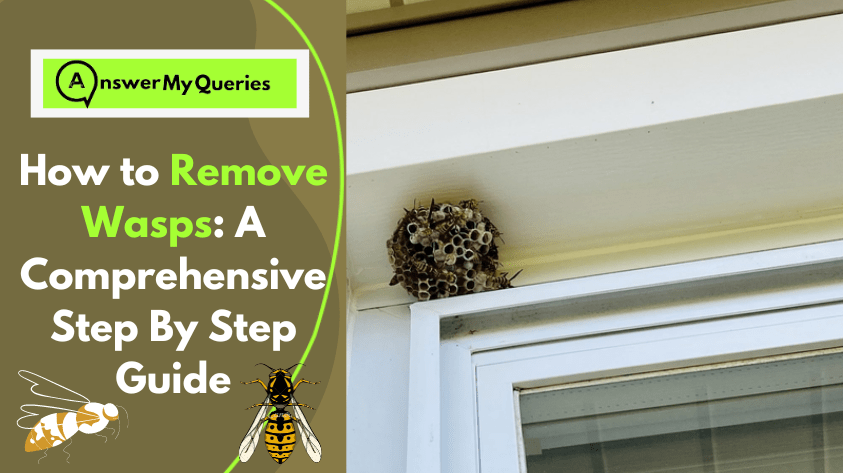
Introduction: How to Remove Wasps? Learn How To Identify Nests and Employ DIY Techniques
Discover effective methods for safe wasp removal in this comprehensive guide How to Remove Wasps? Learn how to identify nests, choose proper protective gear, use natural deterrents, and employ DIY techniques. Find expert tips on nighttime removal, hiring professionals, and preventing future infestations. Ensure a wasp-free environment with step-by-step instructions and FAQs.
When it comes to enjoying the outdoors or simply maintaining a safe and comfortable living space, dealing with wasp infestations can be quite a challenge. Wasps, while essential to the ecosystem, can pose a threat to human health and property. In this guide, we’ll delve into the art of effective wasp removal, covering everything from identifying nests to employing safe and efficient removal methods.

Understanding Wasps
Before embarking on the journey of this article How to Remove Wasps, it’s important to distinguish between wasps and bees. While they share similarities, wasps are often more aggressive and can deliver painful stings repeatedly. Common types of wasps include paper wasps, yellow jackets, and hornets. These insects play a role in controlling other pest populations, making them valuable members of the ecosystem.
The Dangers of Wasp Infestations
Wasp stings can be more than just painful – they can trigger severe allergic reactions in some individuals. For those allergic, a single sting can lead to anaphylaxis, a potentially life-threatening condition. Beyond the health risks, the presence of wasps can limit outdoor activities, and their nesting habits can cause structural damage to homes and other structures.
Identifying Wasp Nests
Knowing where to look for wasp nests is key to effective removal. Nests are commonly found in protected spaces like eaves, attics, and shrubs. Signs of a wasp infestation include increased wasp activity around a particular area and the appearance of small papery nests. Understanding wasp behavior, such as their flight patterns and feeding habits, can aid in locating nests.
Safety Precautions
Safety should be a top priority when dealing with wasp removal. Proper protective clothing, including a beekeeper’s suit and gloves, is essential to prevent stings. Equally important is the use of appropriate equipment such as a wasp spray or insecticide. For individuals who are allergic to wasp stings, having an epinephrine auto-injector on hand is crucial.
Natural Wasp Deterrents
For those looking for eco-friendly ways to deter wasps, natural solutions can be effective. Planting wasp-repelling herbs like spearmint, thyme, and eucalyptus around your property can discourage them from nesting nearby. Creating decoy nests mimicking wasp nests can also convince wasps to establish their colonies elsewhere. Additionally, vinegar-based sprays can disrupt their pheromone trails, deterring their return.
DIY Wasp Removal Methods
For small nests and individuals comfortable tackling the task themselves, several DIY methods are available. Wasp sprays, designed to shoot a stream of insecticide at a distance, can provide quick knockdown of wasps and nests. Traps and baits can capture foraging wasps, reducing their numbers. An unconventional method involves using a vacuum cleaner with a long hose to remove nests safely.
How to Remove Wasps? Well Calling in Professionals is a Good Idea
While DIY methods have their merits, larger nests or hard-to-reach locations might require the expertise of professional pest control services. Pest control professionals have the knowledge, experience, and proper protective gear to handle wasp removal safely and efficiently. They can also identify potential nesting sites and take preventive measures to keep wasps at bay.
Wasp Nest Removal Step-by-Step
- Locating the Nest: To start, carefully observe wasp activity and flight patterns. This can lead you to the nest’s general vicinity.
- Nighttime Removal: Wasps are less active at night, making it safer to approach the nest. Use a red light source to minimize disturbances.
- Wearing Protective Gear: Put on protective clothing, covering as much skin as possible. Don’t forget to protect your face, especially the eyes.
- Using Insecticide: Choose an insecticide labeled for wasp control. Apply it directly to the nest using a long-range spray.
- Removing the Nest: After the insecticide takes effect, carefully cut the nest from its attachment point. Seal it in a plastic bag and dispose of it.
How to Remove Wasp Nest in the Ground?
Dealing with a wasp nest in the ground requires special consideration due to the hidden nature of the nest. Ground-nesting wasps, such as yellow jackets, can be particularly aggressive when their nest is disturbed. To remove a ground-based nest, begin by identifying the nest entrance during the day when wasp activity is at its peak. Once located, plan to remove the nest at dusk or dawn when the wasps are less active.
To protect yourself from stings, wear protective clothing and cover your face. Slowly and carefully apply an appropriate insecticide to the nest entrance, ensuring the entire nest is thoroughly treated. After a day or two, when activity has significantly decreased, you can safely dig up the nest using a shovel. Seal the nest in a plastic bag and dispose of it properly. Remember, ground nest removal can be risky, and if you’re unsure or have concerns, it’s best to seek the help of a professional pest control service.
Feel free to incorporate this paragraph into your article under the “How to Remove Wasp Nest in the Ground?” heading.
Preventing Future Infestations
Do you know How to Remove Wasps easily? The best way to deal with wasps is to prevent them from establishing nests in the first place. Seal openings around your home, such as gaps in siding, cracks in the foundation, and spaces around windows and doors. Keep outdoor spaces clean and free from food debris, and consider incorporating wasp-repelling plants into your landscaping. Regular inspections and maintenance by professionals can also help detect and address potential nesting sites.
Conclusion: How to Remove Wasps
How to Remove Wasps? Removing wasps from your surroundings requires careful planning, protective measures, and an understanding of their behavior. By following the steps outlined in this guide, you can ensure a safe and wasp-free environment for you and your loved ones to enjoy.
FAQs About Wasp Removal
Wasp stings can indeed be dangerous, especially for individuals who are allergic. Their stings can lead to severe allergic reactions or anaphylaxis in some cases.
While smaller nests can be tackled using DIY methods, larger nests and nests in hard-to-reach areas are best handled by professional pest control services.
Preventing wasp infestations involves sealing entry points, keeping outdoor areas clean, and incorporating natural deterrents like wasp-repelling plants.
Not all wasp species are aggressive toward humans. Some are more docile and less likely to sting unless provoked.
Wasps are less active during nighttime, making the removal process safer. Using a red light source reduces the likelihood of provoking them during removal.





